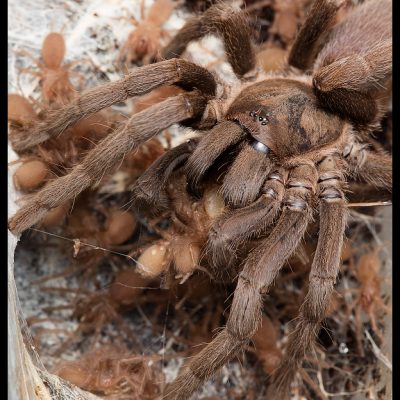
A guide to feeding Australian tarantulas
‘I just bought a tarantula and it won’t eat! What do I do?’ ‘My spider hasn’t eaten for a week! I’m freaking out – is
A fascinating tarantula local to the Cairns region of Far North Queensland. Inhabitants of tropical rainforests, while they do burrow to some degree, they prefer to shelter under rocks and logs. They web extensively, making heavy use of silk sheet networks with one or more entrances leading to their lair below.

While only a diminutive species – females achieving a body length of around 30mm (legspan 65mm) – what’s particularly interesting is their extended maternal care. Many tarantulas will tolerate their own offspring for a short stretch of time, but Semi-social Pygmies happily cohabitate with their young for periods of over a year. Not only do these patient mothers allow the kids to live at home, they also let their young feed from captured prey held in their chelicerae. Siblings share both living quarters and prey as well, with visages not unlike a pride of lions falling on a helpless antelope as they emerge en masse to investigate disturbances on the silk.



In optimal temperatures and with routine feeding, this species can reach sexual maturity by three years, or even before. However, females continue to increase in size after this time, capping out at around 30mm.
The identity of this spider is not scientifically settled, but we will update this page with any new information as it comes.
For those with a particular interest in taxonomy of tarantulas, we will delve into a little more detail.
Currently, the genus Coremiocnemis contains only a single Australian representative: Coremiocnemis tropix, described from a particularly small specimen from Atherton by arachnologist Dr Robert Raven. More than one “variant” of this species appears across its range, appearing distinctly different in at least maximum size, colour and quality of hair. Subsequent to the description of C. tropix, larger spiders were identified by Dr Raven as belonging to this same species.
While it is easy to separate these Coremiocnemis individuals from other genera in Australia using characteristics visible under a microscope, it’s not easy to discern whether or not there are distinct species within this cluster. At this time, it is very possible that multiple species exist within this genus in Australia, and that the true C. tropix is more correctly the smallest of the bunch, living at least out on the Atherton Tablelands. It is possible that all Australian Coremiocnemis belong to a single species, or even that this Pygmy is the “true” C. tropix and larger spiders are not.
We have confirmed that the Semi-social Pygmy featuring on this page belongs in the Australian “Coremiocnemis” genus, but we will have to await further taxonomic work to illuminate exactly what is going on with this particular group of spiders.
Article written by
Do you like this article? Share it on your favourite platform.

‘I just bought a tarantula and it won’t eat! What do I do?’ ‘My spider hasn’t eaten for a week! I’m freaking out – is

The Semi-social Pygmy Tarantula (Coremiocnemis sp.) is a fascinating tarantula local to the Cairns region of Far North Queensland. Inhabitants of tropical rainforests, while they

It’s that time of year again at Minibeast Wildlife when we are pairing up many of our spiders, particularly our tarantulas. In the wild from

Due to the current Covid-19 pandemic, we have obviously had to suspend our physical incursion to schools in both Victoria and Queensland. In response to